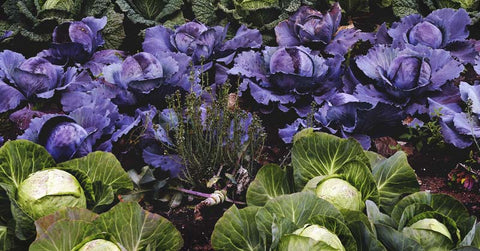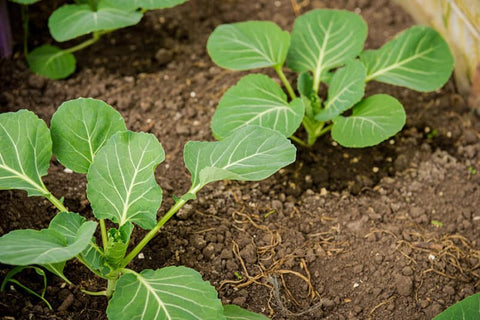If you’re looking to expand your nutritious options while cooking, an excellent place to start is by growing cabbage. Cabbage is full of vitamin B, calcium, iron, protein, and niacin.
Cabbage Plant Info Hardiness Zones: 1, 2, 3, 4, 5, 6, 7, 8, 9
Soil: Sandy, loam, PH between 6.5 to 6.8, well-drained
Sun Exposure: Full sun, at least 6 hours of direct sunlight per day
Planting: Start Indoors: 6 to 10 weeks before the last frost date
Start Indoors (in fall): 6 to 8 weeks before the first frost date Hardening Off: 1 to 2 weeks before transplanting
Transplant Outdoors: When the seedlings have 3 to 4 leaves, 2 to 3 weeks before the last frost date
Spacing: 4 to 6 inches between plants and 2 to 4 feet between rows
Depth: ¼ to ½ inches seed depth
Best Companions: Beans, cucumber, celery, dill, spinach, sage, thyme, onion, lettuce, potato, kale Worst Companions: Tomato, strawberry, broccoli, cauliflower
Watering: Even watering, once a week up to 1½ inches
Fertilizing: Side-dress with compost manure after every 3 weeks, apply balanced fertilizer 3 weeks after transplanting
Common Problems: Anthracnose, black rot, alternaria leaf spot, damping off, clubroot, powdery mildew, sclerotinia stem rot, watery soft rot, white rust, bacterial soft rot, downy mildew, blackleg, ring spot, beet armyworm, cabbage aphid, cabbage looper, cutworms, diamondback moth, flea beetle, cabbage worm, thrips, root knot nematode
Harvest: 50 to 60 days after transplant, when the head is fully formed and feels well-packed and firm when squeezed.
Cabbage Varieties
There are many different varieties of cabbage. I’m going to share with you some of the most common types and their uses so you can decide which is best for you.
Canon Ball Cabbage
This variety looks like an overgrown brussel sprout and is suitable for shredding, making coleslaw, and sauerkraut.
Bok Choy
Excellent for sautéing, stir-fries, and soups due to its tender leaves.
Choy Sum Also known as Chinese cabbage, great for Asian-inspired salads.
Early Jersey Wakefield Cabbage
A green variety weighing around four pounds, suitable for sautéing and steaming.
January King Cabbage
A unique variety with curly, blue, and green leaves, great for roasting.
Napa Cabbage Has a sweeter flavor and is softer, suitable for salads or steaming.
Portugal Cabbage A green cabbage variety with large, ribbed leaves, good for soups.
Red Drumhead Cabbage Adds crunch and color, good for pickling or shredded in coleslaw.
Savoy Cabbage Has curly, green leaves, suitable for salads, stir-fries, fermenting, and kimchi.

Walking Stick Cabbage Grows two to three feet high, more like kale, stems were once used for walking sticks.
Winningstadt Cabbage Dark green leaves with a sheen, suitable for sauerkraut, coleslaws, and salads.
Brussel Sprouts Small cabbages, delicious roasted, sautéed, or steamed.

Green Cabbage A standard green cabbage suitable for coleslaw, sauerkraut, and various dishes.
How to Plant Cabbage
Planting cabbage is not complicated. Follow these steps to start your crop successfully. Cabbage can be grown both in the spring and fall, loving cooler weather in zones 1-9.
Choose the Best Location
Cabbage needs six or more hours of full sunlight a day, well-drained soil, and a pH level of 6.5 to 6.8. After a soil test, improve soil quality with manure, compost, or other nutrients.
Start Your Seeds Indoors
For spring planting, start seeds indoors 6-8 weeks before the last frost. Plant two seeds per 1/2 inch space in small containers. Keep seeds under lights and mist them until it's time to harden off a week before planting.
Planting Seeds Outdoors
For fall planting, start seeds outdoors 6-8 weeks before the first frost. Plant seedlings one to two feet apart, two inches into the ground. Mulch around plants and gauge rain to ensure consistent watering.
How to Care for Cabbage
Cabbage is low-maintenance but requires proper care. Rotate crops yearly to combat soil-borne diseases. Provide plenty of water, maintain soil moisture, and thin overcrowded transplants when they reach five inches tall.
How to Harvest and Store Cabbage
Harvest when the head is fully formed, using a sharp knife to cut it off at the base. Remove the entire root. Most cabbages take around 70 days to harvest.

Conclusion
Growing cabbage can be a rewarding experience for gardeners. Whether you're a beginner or a seasoned pro, adding cabbage to your garden provides a nutritious and versatile vegetable for various culinary purposes. From choosing the right variety to cultivation and dealing with challenges, this guide covers all aspects of growing cabbage successfully. Dive into the aromatic world of cabbage and explore the wonders of this hearty vegetable!









